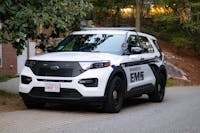Poor parking plans disadvantage students regularly
The people who planned Brandeis cared more about cars than they did about students. There was no formal manifesto made to this effect, but it is clear to anyone who looks hard enough. This has terrible consequences on our environment, in that having cars throughout campus contributes to carbon emission and all those other nasty things. However, it also destroys environment in the more traditional sense: Having so many cars around makes Brandeis an unpleasant place to be a pedestrian, and that is inexcusable for a college campus. One of the more flagrant examples is plain to anyone who tries to walk up the Loop Road hill. Let's recount the many obstacles a student faces walking from the Main Gate up the hill: Our imaginary student must weave around the cars that frequently park on the path by the Shapiro Science Center. After rounding the curve beneath the science complex, she will notice the sidewalk, which is now considerably more uneven and has been reduced to be just wide enough for one person. Farther up the hill, the sidewalk vanishes altogether and she must now join the car traffic inching along nervously behind her. She may, at this point, notice the row of cars parallel parked next to her. She should, if she is not already sufficiently inured, feel outraged. The University is telling her that empty cars are more important than students. Until a plan to replace the disgraceful sidewalk is made, I propose abolishing the parking spots on Loop Road and dedicating the space for students to walk safely instead.
The indignities do not yet cease. When she reaches the plateau between the Usdan Student Center and the Rabb Steps, there is still no path; she must now navigate between two rows of parked cars and one line of moving cars. When she reaches the crosswalk, a police officer may likely tell her to stop and wait for cars to clear the road. In a letter published on student blog Innermost Parts, Brandeis Director of Public Safety Ed Callahan claims that the Brandeis Police "do try to balance all of the needs of pedestrians and vehicle operators." To a student waiting for cars to get past, this cannot seem true. When I complained about the apparent preference given to vehicles, an officer directing traffic told me that cars, in fact, had the priority, despite their unwise timing.
Furthermore, Callahan says "a good percentage of the vehicles in question are operated by faculty who are arriving to teach classes, both undergraduate and graduate students who drive onto campus, as well as BranVans and buses which are deployed to transport students to class." To me it seems that all of these people should know better than to arrive at campus when students are moving between classes during those crucial first 10 minutes of the hour. Instead, students are made to feel like they are crossing a busy city street; it should feel like cars are being inconvenienced for driving through a college.
A recent exhibit in the University Archives makes it quite clear that Brandeis has had a long love affair with the automobile. In 1948, Brandeis was merely a heavily wooded hill, dotted only with some small halls, a library, and a rather conspicuous castle. Compare this vision with Picture 1, Brandeis in 1965. Bare asphalt replaces the dark green woods; parked cars replace the trees. It is hard to find any paths reserved for pedestrians. In Picture 2, from 1975, one can see just how many of our precious few acres are given to parking. Admittedly, this is made clearer since the lots are all empty. Picture 3, from 1982 shows how Brandeis has moved toward the worst of both worlds-vast expanses, which could be wooded, are given away to flat, soulless patches of pavement. However, many of the main roads and pathways are still dotted by cars: Then, as now, students can't walk to the Slosberg Music Center without traversing a parking lot, and students can't leave the front of the Castle without negotiating a small piece of pavement shared with both parked and moving cars.
The University does recognize the problem. Callahan claims to support a "car-free campus." Picture 4, the 2001 Master Planning document, suggests the Office of the Executive Vice President for Capital Projects would also like to move in this direction. Note how cars would not be allowed to travel further than the turn for North Parking Lot; the piece of land between Usdan and the Rabb Steps would be returned to pedestrians.
The most obvious solution to this problem would be the creation of a multi-story parking deck; they're unsightly, to be sure, but would make much less of a footprint and could lead to the partial reforestation of campus. I still think Loop Road parking should be abolished entirely, so students can have a safe place to walk. Until capital projects can alleviate the problem, though, cars and drivers should be made to feel more inconvenienced: Have more people park in Charles River Lot or somehow convince people who roll into campus at 12:04 p.m. that they may have to wait more than three minutes to make it through the Rabb crossing. Everything should be done to make students, and all pedestrians feel like campus space belongs to them and not cars.



Please note All comments are eligible for publication in The Justice.